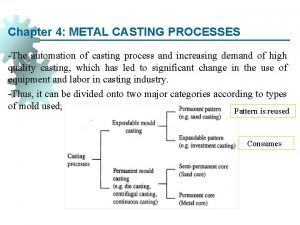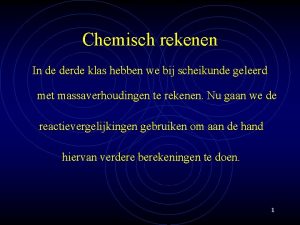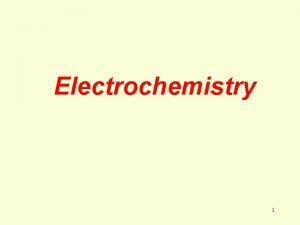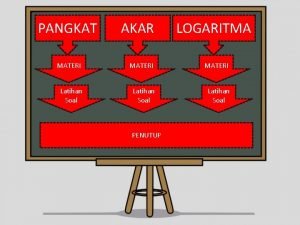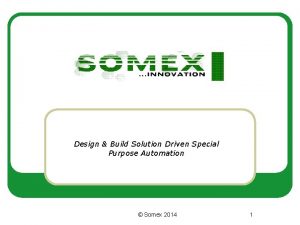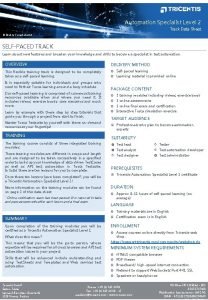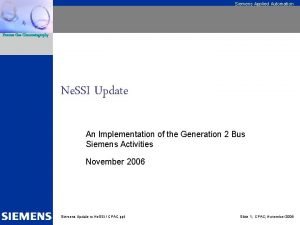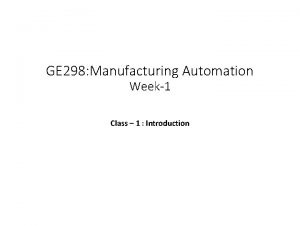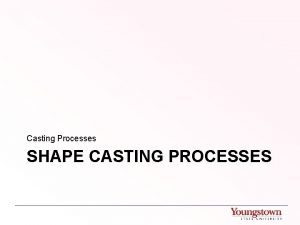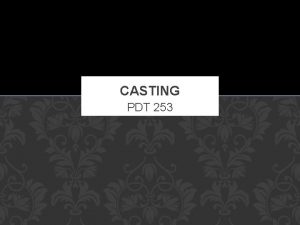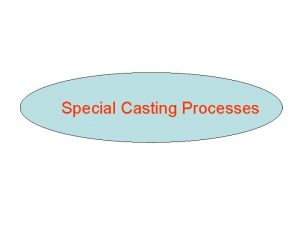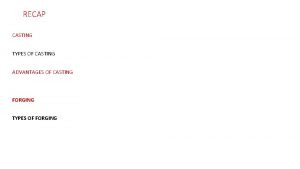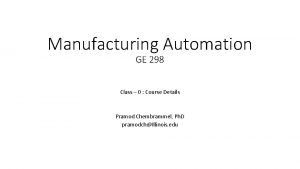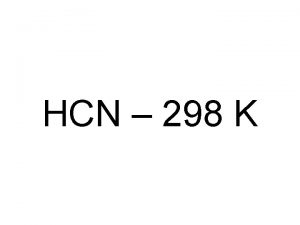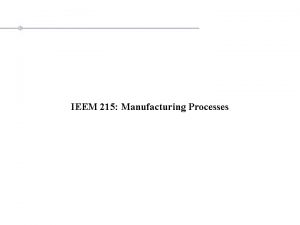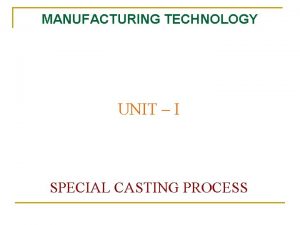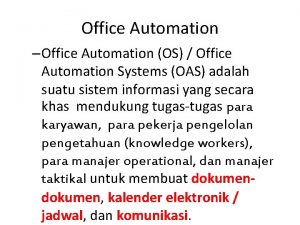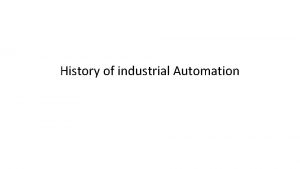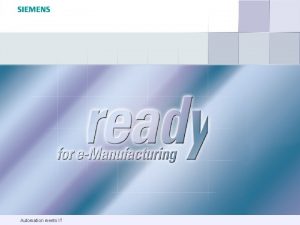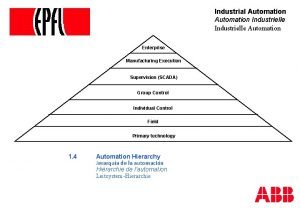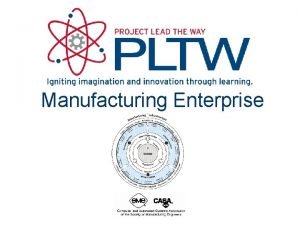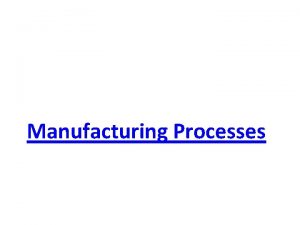GE 298 Manufacturing Automation Week1 Class2 Casting Casting
























- Slides: 24

GE 298: Manufacturing Automation Week-1 Class-2: Casting

Casting • Introduction of molten metal into a mold cavity where the metal confirms to the shape of the cavity • Intricate shapes in a single piece • Internal cavities • Very small and hollow parts can be produced Important factors in casting operations • Solidification • Molten metal into metal cavity • Heat transfer during solidification and cooling of the metal in the mold • Influence of the type of the mold material • Questions from SME Videos?

Ingot casting and Continuous Casting • Ingots: First solid form of raw Ingots are used forging , further material casting etc. • Ingots are passed into Ingot mold. Squares, Rectangular, circular cross sections Ferrous Ingots • Oxygen present in the molten metal is rejected out of the casting when temperature drops • Oxygen combines with carbon to form carbon monoxide causes porosity Killed steel • Add Aluminum or silicon to form oxides, which deoxidizes the metal, causes shrinkage cavities, lot of scrap.

Semi Killed steel • Partially deoxidized, some porosity, Economical Rimmed steel • Lots of blowholes, Usually low carbon steel (0. 15% Carbon)

Expendable casting/Permanent mold Casting • Sand, Plaster, Ceramics • Usually refractories which withstand high temperature of molten metal. Sand casting • Si. O 2 -> Silica sand • Naturally bonded, synthetic ( lake sand) Factors: Fine round grains, good permeability, allows gases to go out. Types of sand molds Green Sand Cold box No bake molds Moist/damp skin Organic and Synthetic resin Dried/over dried Inorganic Binder with sand

Various features of a sand mold Pouring basin(cup) Open riser Vent Core Sand Flask Blind Riser Cope Sand Parting line choke Drag Mold Cavity Sand Runner gate

Patterns • • • Patterns are made in the shape of the casting Pattern Materials: Wood, Plastic or metal. Size, shape, dimensional accuracy, number of components. Parting agents. One piece or multiple piece pattern

A typical match plate pattern used in sand casting Cope side plate Drag side

Pattern Allowances • Shrinkage Allowance Patterns are made larger than the casting to compensate contraction of the liquid while freezing. For internal cavities the allowances should be negative. If a is the coefficient of thermal expansion, l is the dimension of the casting then the shrinkage allowance will be a |(q- q o)|

Cores • Cores are used to create internal cavities. • Should have similar properties as the mold. • Shaken out after finished casting is produced. • Core Print, Chaplets • Core Boxes

Design of Casting • Riser - location • Corners, angles and sections • No sharp corners, angles or fillets • cracking, tearing during solidification • Too large fillet radius? • Smooth sections • Flat areas • Parting lines

Machining Allowance required to remove the rough cast surface. 2 to 25 mm (0. 1 to 1’) Draft Allowance To facilitate ease of removal, usually ½ to 2 deg. Shrinkage allowance Normal shrinkage: Cast iron 0. 83 to 1. 3% Aluminum - 1. 3%

Plaster Mold Casting Plaster of Paris( Calcium Sulfate, Gypsum) + silica flour The mixture is poured over the pattern (instead of sand) POP has low permeability, gases cannot escape Antioch process : Dehydrate & Rehydrate Usually used for low temperature alloys like aluminum, brass etc. ( metal with melting point below 2000 F) • Components: gears, valves, tooling, ornaments • High precision process. • • •

Ceramic Mold Casting • Similar to plaster mold. Ceramic slurry • Mixture of fine grained Zircon (Zr. Si 04), aluminum oxide and fused • Shell is baked at high temperature Uses • High temp alloys, expensive process Parts • Stainless Steel or tool steel parts Examples • Impellers, cutters, dies etc.

Evaporative pattern casting • Lost Pattern Casting • Polystyrene pattern • Evaporates when it comes in contact with molten metal Process • Polystyrene beads are placed in preheated die, usually aluminum die. The polystyrene expands and fills die cavity. Again heated to fuse the beads.

Investment Casting • Lost wax process: 4000, 3000 BC • Patterns are made of wax, urea, plastic. Shell = Silica & binder, ethyl silicate binder & acids, Zircon flour • Intricate shape, precision parts High temperature process. Parts: Aircraft components, gears, cams, valves, jewelry. • Molten metal is passed in vacuum to reduce oxidation, isostatic pressure is applied to reduce micro porosity ( 15 ksi pressure at 900 def F)

Schematic illustration of Investment casting Mold to make pattern Injecting wax or plastic pattern Slurry coating Wax pattern Ejecting pattern Pattern assembly (tree) casting Stucco coating Completed mold Molten metal Pattern meltout pattern Pouring Shakeout Castings by this method cab be made with very fine detail and from variety of materials

Permanent Mold Casting • Metal mold - permanent • • Pre-Heated dies Water cooled Good surface finish - good for automation Piston, Cylinder heads, connecting rods etc

Pressure Casting • Pressure applied while filling the casting Die Casting • Permanent mold method • Hot Chamber • Cold Chamber

Low pressure casting Railroad wheel Graphite mold Air pressure Molten metal Airtight chamber ladle Refractory tube

Hot chamber Die casting • 2000 psi Die cavity Goose neck Hydraulic shot cylinder Plunger rod plunger Molten metal pot

Cold Chamber die casting Ejector platen • 3 to 10 Ksi • in the range of 5000 psi (Moves) Ejector die half Stationary platen Hydraulic cylinder ladle Ejector box Stationary die half Shot sleeve Plunger rod Sequence of operations in die casting of part in the cold chamber process

Various types of die casting dies Single cavity die Combination die Multiple cavity die Unit die

Centrifugal Casting
 Automation in casting process
Automation in casting process Manufacturing cost vs non manufacturing cost
Manufacturing cost vs non manufacturing cost Manufacturing cost vs non manufacturing cost
Manufacturing cost vs non manufacturing cost Additive manufacturing steps
Additive manufacturing steps Job vs process costing
Job vs process costing Uncontrollable cost example
Uncontrollable cost example Schema chemisch rekenen
Schema chemisch rekenen Kaidah logaritma
Kaidah logaritma Operational security
Operational security The emf of daniell cell at 298 k is e1
The emf of daniell cell at 298 k is e1 Two independent sample t test spss
Two independent sample t test spss Contoh soal kaidah kaidah logaritma
Contoh soal kaidah kaidah logaritma L 298 n
L 298 n Decreto 298/2022
Decreto 298/2022 Dengan melogaritmakan kedua ruas hitunglah x untuk 3x+1=27
Dengan melogaritmakan kedua ruas hitunglah x untuk 3x+1=27 Somex automation
Somex automation Tricentis automation specialist level 1
Tricentis automation specialist level 1 Service assurance automation
Service assurance automation Siemens chromatography
Siemens chromatography Sales order automation sap
Sales order automation sap Hp cloud orchestration
Hp cloud orchestration Shalu automation
Shalu automation Ca 7 edition
Ca 7 edition Wordpress deployment automation
Wordpress deployment automation Mukesh otwani selenium interview questions
Mukesh otwani selenium interview questions
